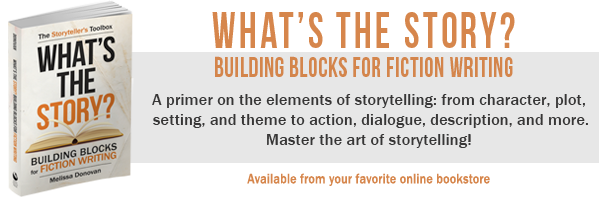Today’s post includes excerpts from What’s the Story? Building Blocks for Fiction Writing, chapter eleven: “Concept, Premise, and Loglines.” Enjoy!
Most audiences are first introduced to stories as concepts, premises, or loglines.
These are hooks used for pitching and marketing; they draw people’s attention, get them interested in a story, and compel them to buy it.
Writers often start with a concept or premise as the initial idea for a story. It’s certainly not the only way for a story to be born, but identifying a clear concept or premise early on can lend clarity as you work your way through the composition of a story.
People often confuse the words concept and premise and use them interchangeably, but they have different meanings, which are important for storytellers to understand.
Concept
Concept tells us what a story is about—the core idea of a story. There are two types of concepts: low concepts and high concepts.
Low Concepts
Low concepts are simple and can come off as generic or mundane at first glance. However, these stories often contain more character development and nuance than their high-concept counterparts.
Low concepts don’t have built-in conflicts and antagonists. Nor do they appear on their surfaces to be particularly unique or compelling. They are more difficult to pitch or sell because they’re harder for audiences to envision. However, if well executed, low-concept stories can perform well.
Here are some examples of low concepts: two teenagers fall in love; a widow struggles with grief; a detective solves a crime.
Teenagers fall in love every day. What’s so interesting about that? This is what makes low concept a harder sell; it often needs to be worked into a fuller premise to hold any real interest.
High Concepts
High concepts pack a lot of punch in just a few words. They often wrestle with what-if questions and tend to contain built-in appeal while conveying a fresh or original idea—or a new twist on an old idea. Many high concepts focus on primal emotions and situations, such as survival or finding love. The conflict and genre are often self-evident. These concepts are visual; in just a few words, they spark people’s imaginations. A one-line description is enough to draw people’s attention:
- What if scientists built dinosaurs from preserved DNA? (Jurassic Park)
- A lonely orphan is invited to a secret school for young wizards. (Harry Potter)
- What happens when artificial intelligence surpasses human intelligence? (The Terminator, The Matrix, Battlestar Galactica)
As you can see, these are all genre stories, which isn’t unusual; science fiction and fantasy lend themselves particularly well to high concepts.
Premise
Concepts are often too broad and are only interesting on the surface—even high concepts. A hundred storytellers could start with the same concept—high or low—and they’ll end up with a hundred different premises. For example, you could take the idea of genetically engineered dinosaurs in many different directions. The dinosaurs could be built in a lab and then escape and wreak havoc on a metropolitan population. Their DNA could be mixed with human DNA, resulting in a highly intelligent species that wants to wipe out its main competitor—humans. And the dinosaurs don’t have to be antagonistic: they could help humans solve a serious problem. Maybe they can communicate with the aliens that have just arrived. Now we’re heading toward something that resembles a premise.
A concept is an idea for a story, whereas a premise is a very brief sketch of a story. Concept gives us a general idea of what a story is about—a view from afar. Premise pulls the camera in closer so that we get a better sense of what’s going on in this story.
A premise introduces character, plot, and possibly setting. It gives us a sense of the obstacles the characters will face. It goes into specifics:
- Scientists build dinosaurs from preserved DNA and then fight them off when they threaten to take over a theme park that is under construction. (Jurassic Park)
- A lonely orphan is invited to a secret school for young wizards, where he will eventually acquire the skills and allies he needs to face the evil and powerful wizard who killed his parents. (Harry Potter)
- Two teenagers from rival families fall in love and make the ultimate sacrifice for each other. (Romeo and Juliet)
The premise for Romeo and Juliet shows how a low concept (two teenagers fall in love) can be turned into a more compelling premise with a little tweaking.
As you can see, a premise expands on a concept, making it more interesting by adding details about the story’s world or conflict. A premise reveals details about the protagonist, provides the story’s setup, and identifies the antagonist and the core conflict.
Want to learn more about developing a compelling story concept? Pick up a copy of What’s the Story? Building Blocks for Fiction Writing.






Very helpful! I plan to attend the Midwest Writers Workshop next month and need an elevator pitch. Your post gives me a way to imagine my books from general to more specific. Thanks!
I’m so glad this post was helpful to you. Enjoy the workshop!
A very helpful post. You have made it much clearer in my mind. Thank you.
It helped me for doing my filmmaking assignment. Thank you so much.
You’re welcome!